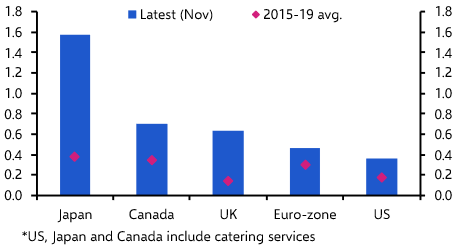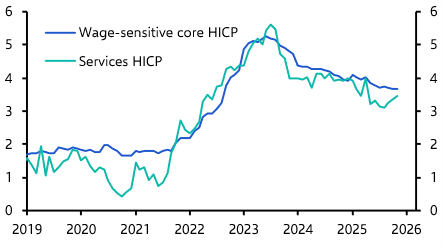In my note last week I argued that the trend decline in bond yields over the past couple of decades could be justified by shifting economic forces and thus did not represent the “bubble” that many now fear. Notwithstanding this, however, it remains possible that the bond market may have got ahead of itself over the summer. After all, the scale of interest rate cuts that is now priced into the market in the US has only previously been delivered in the modern era in times of recession. This raises two questions: what has spooked the bond markets, and just how bad is the global economic outlook?
Three things seem to have driven the sharp fall in global bond yields over the past month or so. The first – and most obvious – is growing evidence that the world economy is slowing. Global manufacturing is now in recession and the business surveys suggest that conditions are likely to deteriorate further over the coming months. Last week brought the news that the US ISM Manufacturing Index fell to below the crucial 50-mark that’s supposed to be the dividing line between expansion and contraction in August. We also learnt that German industry contracted for the third time in four months in July.
The second factor that has driven bond yields lower has been the further ratcheting up in the US-China trade war. Additional tariffs on US imports from China came into force at the start of this month and further increases are scheduled for next month. Central bankers have begun to cite the trade war as a key driver of weaker growth.
Related to this, the third factor that has pushed down bond yields has been a shift by policymakers. The Fed has already cut interest rates once and signalled further cuts to come over the coming months. In the background, President Trump is piling pressure on the Fed to do more. Meanwhile, the ECB has laid the groundwork for additional policy support at this month’s board meeting. And monetary policy has also been loosened in major EMs, including China, India, Brazil, Mexico and Russia.
This brings me to my second question: just how bad is the economic outlook? As regular readers will know, we have been among the most bearish forecasters over the past 12 months or so. This time last year we argued that the global economic cycle had peaked and that growth was likely to slow sharply this year, causing central banks to loosen policy and bond yields to fall. The events of the past few months have vindicated this view.
Nonetheless, it’s difficult to escape the feeling that the bond markets may have run a bit ahead of themselves. The recent data from the manufacturing sector has been grim but service sectors have continued to hold up. (The drop in the US Manufacturing ISM grabbed the headlines last week, but Non-Manufacturing Index released a few days later actually picked up.) And while trade wars are a convenient scapegoat for central banks, we struggle to find much evidence that they have caused significant economic damage to either the US, China or Europe.
Stepping back, the main reason why we anticipated weaker growth this year was that we expected the lagged effect of earlier policy tightening in the US and China to weigh on demand in the world’s two largest economies. Yet monetary policy (and financial conditions) in both countries is now loosening. So what was a headwind is now starting to turn into a tailwind.
In uncertain times history can be a useful guide to the future. It suggests that recessions tend to be caused by one or more of six things:
- A tightening of monetary policy;
- A tightening of fiscal policy;
- The bursting of a credit bubble/debt crisis;
- The bursting of a housing/asset price bubble;
- Balance of payment crises; and
- Banking crises.
Running down this list doesn’t set alarm bells ringing. As I’ve just noted, monetary policy is now being loosened in the world’s major economies. The same is true of fiscal policy.
The rapid expansion of credit in China is unsustainable and much of the recently issued debt will turn bad, but we expect this to result in a period of structurally weaker growth over several years rather than an imminent crisis. Likewise, Italy’s debt dynamics remain precarious but the immediate risks have diminished.
Property markets in a handful of countries, including Canada and Hong Kong, look frothy, but the housing downturn in Australia may be bottoming out. And while a handful of EMs, most obviously Argentina, face balance of payment and banking sector risks, the threat of contagion is low.
Most importantly, none of the usual causes of recession appear to be lurking on the horizon in the world’s major advanced economies. Last week we unveiled our proprietary recession indicator for the US. It suggests that, while the risks have risen in recent months, there is still only around a 20% probability that the US will experience a recession within the next year. (Similar indicators for other economies will follow over the coming months.)
Of course, that doesn’t mean that a recession can’t happen. (I outlined some of the key tail risks a few weeks ago.) But as things stand it feels to us like the bigger threat is a prolonged period of low growth and low inflation, rather than an outright recession. If that’s right, then the rally in the bond markets over the past month or so may have gone too far.
In case you missed it:
- Our Head of Global Economics, Jennifer McKeown, assesses the mounting costs of negative interest rates.
- Our Emerging Markets Economist, Edward Glossop, argues that recent currency weakness won’t prevent EM central banks from loosening policy further.
- Our UK team take stock of yet another rollercoaster week in Brexit.



